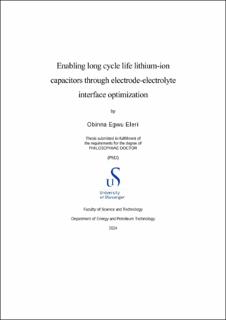| dc.contributor.advisor | Lou, Fengliu | |
| dc.contributor.advisor | Yu, Zhixin | |
| dc.contributor.author | Eleri, Obinna Egwu | |
| dc.date.accessioned | 2024-03-20T14:43:55Z | |
| dc.date.available | 2024-03-20T14:43:55Z | |
| dc.date.issued | 2024 | |
| dc.identifier.citation | Enabling long cycle life lithium-ion capacitors through electrode-electrolyte interface optimization by Obinna Egwu Eleri, Stavanger : University of Stavanger, 2024 (PhD thesis UiS, no. 749) | en_US |
| dc.identifier.isbn | 978-82-8439-225-7 | |
| dc.identifier.issn | 1890-1387 | |
| dc.identifier.uri | https://hdl.handle.net/11250/3123467 | |
| dc.description.abstract | Electrode-electrolyte interfaces in electrochemical cells represent critical boundaries between the electrode and electrolyte where most charge transfer or storage processes are initiated. Accordingly, the interface properties can influence the performance of electrochemical cells, affecting the capacity, energy and power density, electrode stability and cycle life. This is particularly significant in lithium-ion capacitors (LiC), a hybrid energy storage consisting of high surface area capacitive cathodes such as activated carbon (AC) from Supercapacitors (SC) and intercalation/alloying anodes such as graphite or hard carbon (HC) from Lithium-ion batteries (LiB) while using similar LiB electrolytes with large operating potential windows. However, the AC widely adopted as LiC cathode often possesses surface oxygenated functionalities and numerous defects from the extensive activation treatment to impact the high surface area. As a result, the AC electrode is enriched in active sites for accelerated electrolyte decomposition, which can cause rapid capacity fade and failure of such cells. Furthermore, the sensitive LiPF6 salt widely adopted in LiB electrolyte formulations is prone to hydrolysis, which may inadvertently proceed upon contact with confined moisture in the AC pores. Degradation by-products, such as HF and PF5, are formed, which may catalyse other component degradation and are detrimental to interfacial stability. Consequentially, the cycle life of the LiC is affected by these processes occurring on the AC and remains inferior compared to SC.
In the first part of this study, the capacity fade mechanism of the AC cathode in a LiC cell was investigated by a combination of electrochemical and post-mortem material characterisation techniques. First, the stability was probed using sustained floating voltage holds and intermittent electrochemical spectroscopy to examine the interfacial transformations during cycling. Then, the AC electrode surface was further examined ex-situ, utilising a variety of post-mortem characterisations after different durations of cycling to reveal changes in the surface area, defect level, and surface species with the capacity fade. Finally, the results showed that the capacity fade was caused by the synergistic effect of electrolyte degradation and active material interface transformation by the deposited degradation products.
The second part examined the effect of electrolyte dielectric on the performance of the AC in symmetric cell configuration and in half cells with lithium counter electrodes. Electrolyte solutions with varying dielectrics were prepared and tested in the mentioned cellular configuration. High electrolyte dielectric was revealed to improve cycle life by delaying the PF6- anion degradation at the AC electrode surface. Furthermore, the increased electrolyte dielectric enhanced the oxidative stability of the PF6- anion through a sufficiently strengthened solvation shell. These properties enhanced the cycle life and decreased features associated with electrolyte degradation in the high-dielectric electrolyte.
The third part investigated the effect of electrolyte dielectric on the interfacial properties of the AC cathode and Hard carbon (HC) anode in a LiC full cell. Post-mortem characterisations and electrochemical impedance analysis were used to probe the AC and HC electrode interfaces. High electrolyte dielectric was revealed to be particularly beneficial for the AC cathode, with a three-fold decrease in interfacial impedance observed as the electrolyte dielectric was increased. Overall, increasing the electrolyte dielectric presents a method for extending the cycle life of AC LiC. | en_US |
| dc.language.iso | eng | en_US |
| dc.publisher | Stavanger, University of Stavanger | en_US |
| dc.relation.ispartofseries | PhD thesis UiS;749 | |
| dc.relation.haspart | Paper 1: Eleri, O.E., Lou, F. & Yu, Z. (2023) Lithium-ion capacitors: A review of strategies towards enhancing the performance of the activated carbon cathode. Batteries, 9(11), 533. DOI:10.3390/batteries9110533 | en_US |
| dc.relation.haspart | Paper 2: O. E. Eleri, F. Huld, J. Pires, W. M. Tucho, P. Schweigart, A. M. Svensson, F. Lou, and Z. Yu. (2023) Revealing mechanisms of activated carbon capacity fade in lithium-ion capacitors.Revealing mechanisms of activated carbon capacity fade in lithium-ion capacitors. Electrochimica Acta, 453, 142359. DOI: 10.1016/j.electacta.2023.142359 | en_US |
| dc.relation.haspart | Paper 3: O. E. Eleri, J. Pires, F. T. Huld, S. Lu, P. Schweigart, A. M. Svensson, F. Lou, and Z. Yu. (2023) Enhanced activated carbon lithium-ion capacitor electrochemical stability through electrolyte dielectric optimisation. Sustainable Energy & Fuels, 7(8), 1846-1854. DOI: 10.1039/D3SE00122A. This paper is not included in the repository due to copyright restrictions. | en_US |
| dc.relation.haspart | Paper 4: O. E. Eleri, F. T. Huld, F. Lou, and Z. Yu. (2023) Deciphering electrolyte dielectric extended electrochemical stability in lithium-ion capacitors. Electrochimica Acta, 464, 142960. DOI: 10.1016/j.electacta.2023.142960 | en_US |
| dc.rights | Navngivelse 4.0 Internasjonal | * |
| dc.rights.uri | http://creativecommons.org/licenses/by/4.0/deed.no | * |
| dc.subject | petroleumsteknologi | en_US |
| dc.title | Enabling long cycle life lithium-ion capacitors through electrode-electrolyte interface optimization | en_US |
| dc.type | Doctoral thesis | en_US |
| dc.rights.holder | © 2023 Obinna Egwu Eleri | en_US |
| dc.subject.nsi | VDP::Teknologi: 500::Berg‑ og petroleumsfag: 510::Petroleumsteknologi: 512 | en_US |

